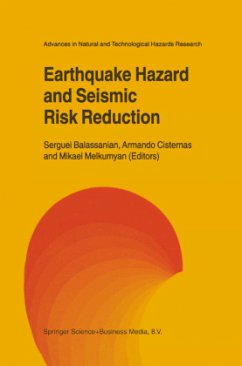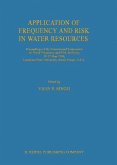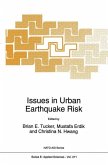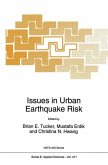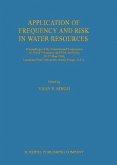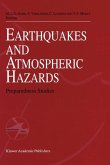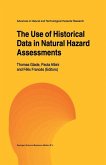Earthquake Hazard and Seismic Risk Reduction
Herausgegeben:Balassanian, Serguei; Cisternas, Armando; Melkumyan, Mikael
Earthquake Hazard and Seismic Risk Reduction
Herausgegeben:Balassanian, Serguei; Cisternas, Armando; Melkumyan, Mikael
- Broschiertes Buch
- Merkliste
- Auf die Merkliste
- Bewerten Bewerten
- Teilen
- Produkt teilen
- Produkterinnerung
- Produkterinnerung
In 1998 Armenia was commemorating the tenth anniversary of the catastrophic Spitak earthquake. The Second International Conference on "Earthquake Hazard and Seismic Risk Reduction" sponsored by the Government of the Republic of Armenia and United Nation's International Decade for Natural Disaster Reduction (UN/IDNDR) was held in dedication to that event between 14-21 September (later referred to as Yerevan Conference). The Yerevan Conference has been organized by the National Survey for Seismic Protection (NSSP) of the Republic of Armenia. All level's decision-makers (from the ministers to the…mehr
Andere Kunden interessierten sich auch für
![Application of Frequency and Risk in Water Resources Application of Frequency and Risk in Water Resources]() Application of Frequency and Risk in Water Resources116,99 €
Application of Frequency and Risk in Water Resources116,99 €![Issues in Urban Earthquake Risk Issues in Urban Earthquake Risk]() B.E. Tucker / Mustafa Özder Erdik / Christina N. Hwang (Hgg.)Issues in Urban Earthquake Risk161,99 €
B.E. Tucker / Mustafa Özder Erdik / Christina N. Hwang (Hgg.)Issues in Urban Earthquake Risk161,99 €![Issues in Urban Earthquake Risk Issues in Urban Earthquake Risk]() Issues in Urban Earthquake Risk154,99 €
Issues in Urban Earthquake Risk154,99 €![Application of Frequency and Risk in Water Resources Application of Frequency and Risk in Water Resources]() V.P. Singh (Hrsg.)Application of Frequency and Risk in Water Resources121,99 €
V.P. Singh (Hrsg.)Application of Frequency and Risk in Water Resources121,99 €![Earthquake and Atmospheric Hazards Earthquake and Atmospheric Hazards]() Earthquake and Atmospheric Hazards39,99 €
Earthquake and Atmospheric Hazards39,99 €![The Use of Historical Data in Natural Hazard Assessments The Use of Historical Data in Natural Hazard Assessments]() GladeThe Use of Historical Data in Natural Hazard Assessments121,99 €
GladeThe Use of Historical Data in Natural Hazard Assessments121,99 €![Anatomy of an Orogen: The Apennines and Adjacent Mediterranean Basins Anatomy of an Orogen: The Apennines and Adjacent Mediterranean Basins]() VaiAnatomy of an Orogen: The Apennines and Adjacent Mediterranean Basins187,99 €
VaiAnatomy of an Orogen: The Apennines and Adjacent Mediterranean Basins187,99 €-
-
-
In 1998 Armenia was commemorating the tenth anniversary of the catastrophic Spitak earthquake. The Second International Conference on "Earthquake Hazard and Seismic Risk Reduction" sponsored by the Government of the Republic of Armenia and United Nation's International Decade for Natural Disaster Reduction (UN/IDNDR) was held in dedication to that event between 14-21 September (later referred to as Yerevan Conference). The Yerevan Conference has been organized by the National Survey for Seismic Protection (NSSP) of the Republic of Armenia. All level's decision-makers (from the ministers to the local authorities), politicians, scientists, leaders of the executive and legislative powers, psychologists, leading businessmen, representatives from the private sector and the media as well as from the International Organizations have been invited by the Armenian NSSP to take part in joint discussion of the Seismic Risk Reduction Problem for the first time in the history of such forums. Armenian NSSP's such initiative has been triggered by the experience of the Spitak earthquake and other disasters. They showed that it will be possible to reduce the risks, posed by the natural disaster, only through the common efforts of all the community in co-operation with the International institutions.
Produktdetails
- Produktdetails
- Advances in Natural and Technological Hazards Research 12
- Verlag: Springer / Springer Netherlands
- Artikelnr. des Verlages: 978-90-481-5497-5
- Softcover reprint of the original 1st ed. 2000
- Seitenzahl: 464
- Erscheinungstermin: 12. Dezember 2011
- Englisch
- Abmessung: 235mm x 155mm x 25mm
- Gewicht: 734g
- ISBN-13: 9789048154975
- ISBN-10: 9048154979
- Artikelnr.: 32032431
- Herstellerkennzeichnung Die Herstellerinformationen sind derzeit nicht verfügbar.
- Advances in Natural and Technological Hazards Research 12
- Verlag: Springer / Springer Netherlands
- Artikelnr. des Verlages: 978-90-481-5497-5
- Softcover reprint of the original 1st ed. 2000
- Seitenzahl: 464
- Erscheinungstermin: 12. Dezember 2011
- Englisch
- Abmessung: 235mm x 155mm x 25mm
- Gewicht: 734g
- ISBN-13: 9789048154975
- ISBN-10: 9048154979
- Artikelnr.: 32032431
- Herstellerkennzeichnung Die Herstellerinformationen sind derzeit nicht verfügbar.
I. Disaster Reduction.- Seismic Risk Reduction Strategy in the XXI Century.- Building Local Capacity for Earthquake Loss Reduction.- Disaster Assistance in Cold Weather Conditions: an Overview of Issues and Options.- Actual State of Technical Cooperation on Earthquake Disaster Prevention Case Study: JICA Earthquake Disaster Prevention Project in Mexico.- Radius Initiative for IDNDR a Practical Approach to Reduce Urban Seismic Risk.- Urban Seismic Risk Mitigation in Asia: Examples From Radius Case Studies.- The Kathmandu Valley Earthquake Risk Management Project (KVERMP): Project Motivation and Description.- The Role of the Subjective Factors in the Seismic Risk.- II. Earthquake Hazard.- Major and Great Earthquakes on the Himalayan Region: an Overview.- Seismicity of the Spitak Earthquake Source Zone Vicinity.- Southern Javakhet Earthquake Swarm. Stress Tensor Orientation Derived from Focal Mechanism Data.- The Digital Accelerograph Network in the Caucasus.- Implications of the Duration of Strong Ground Motion: (Observations from the U.S. Loma Prieta Earthquake of Oct. 17, 1989).- Seismicity and Cultural Monuments of Georgia.- Geomorphological Aspects of the Forming of Earthquake Intensity Effect in Highlands.- On Estimation of Dominant Vibration Periods of Site.- A Major Neotectonic Structure Within the Arabia - Eurasia Collisional Orogen: the Ararat - Araks Conjugate Fault System and its Possible Impact on the Safety of the Metsamor Nuclear Power Plant.- One Inequality of Elastokinetics and its Application in Seismology.- Earthquake Prediction Research for Current Seismic Hazard Assessment in Armenia.- The Stages of Earthquake Preparation: Laboratory Experiment and Field Study.- Earthquake Prediction: Pro and Contra.- Method of Analysis of Geochemical Oscillationsto Earthquake Prediction.- Earthquake Prediction Research in China: Zhangbei Ms=6.2 Earthquake on January 10, 1998.- Intense Crustal Deformation Rates on Nissyros Island (Greece), Deduced from GPS Studies, May Foreshadow a Forthcoming Volcanic Event.- Tectonic Early Warning System Through Real-Time Radon (Rn) Monitoring: Preliminary Results of a Geophysical Method for Forecasting Earthquakes.- The Results of Theoretical Researches of the Geodesic-Deformed Herald of Earthquakes.- Seismic Hazard Zonation in Eastern Europe.- A New Seismic Hazard Map for the Implementation in the National Physical Planning of Iran.- III. Earthquake Engineering.- Ten Years After the 1988 Spitak Earthquake: Reconstruction and New Lines of Earthquake Engineering Development in Armenia.- The Lessons of Armenia-Spitak, 1988, and Other Recent Earthquakes in View of Seismic Building Codes Improvement.- The Nature of Spitak Earthquake Occurred on December 7, 1988. Reinforcement and Repair Technology of Buildings and Constructions.- Some Structural Aspects of Buildings Destroyed in the Spitak Earthquake.- Seismic Upgrading of Existing Stone-Masonry Buildings: Lessons From the Earthquake of Bovec of 1998.- On Basic Concepts for Development of United International Earthquake Resistant Construction Code.- Analysis of New Seismic Building Codes of CIS Countries.- Recent Techniques and Regulations on Seismic Retrofit and Diagnosis for Buildings in Japan.- Some Main Principles of New Republic Codes on Design and Construction of Seismic- Resistant Masonry Structures.- Internet Availability of the Vulnerability Database.- Assessment of Damage and Usability of Earthquake-Damaged Buildings: Experience of Slovenia.- Design and Testing of High Damping Rubber Earthquake Bearings for Retrofit Project in Armenia.- The Research, Application and Design Code of Seismic Isolation and Energy Dissipation in China.- On one Approach of Studying the Free and Forced Vibrations of Bases and Fundaments of Structures.- Activities of the European Laboratory for Structural Assessment for Seismic Risk Reduction in Europe.- Effects of Incoherence, Wave Passage and Spatially Varying Site Conditions on Bridge Response.- The Impact of the System of Ties Upon the Level of Seismic Effect for Road Beam Bridges.- The Asymptotic Solution of Some Model Problems of Seismostability Construction and Seismology.
I. Disaster Reduction.- Seismic Risk Reduction Strategy in the XXI Century.- Building Local Capacity for Earthquake Loss Reduction.- Disaster Assistance in Cold Weather Conditions: an Overview of Issues and Options.- Actual State of Technical Cooperation on Earthquake Disaster Prevention Case Study: JICA Earthquake Disaster Prevention Project in Mexico.- Radius Initiative for IDNDR a Practical Approach to Reduce Urban Seismic Risk.- Urban Seismic Risk Mitigation in Asia: Examples From Radius Case Studies.- The Kathmandu Valley Earthquake Risk Management Project (KVERMP): Project Motivation and Description.- The Role of the Subjective Factors in the Seismic Risk.- II. Earthquake Hazard.- Major and Great Earthquakes on the Himalayan Region: an Overview.- Seismicity of the Spitak Earthquake Source Zone Vicinity.- Southern Javakhet Earthquake Swarm. Stress Tensor Orientation Derived from Focal Mechanism Data.- The Digital Accelerograph Network in the Caucasus.- Implications of the Duration of Strong Ground Motion: (Observations from the U.S. Loma Prieta Earthquake of Oct. 17, 1989).- Seismicity and Cultural Monuments of Georgia.- Geomorphological Aspects of the Forming of Earthquake Intensity Effect in Highlands.- On Estimation of Dominant Vibration Periods of Site.- A Major Neotectonic Structure Within the Arabia - Eurasia Collisional Orogen: the Ararat - Araks Conjugate Fault System and its Possible Impact on the Safety of the Metsamor Nuclear Power Plant.- One Inequality of Elastokinetics and its Application in Seismology.- Earthquake Prediction Research for Current Seismic Hazard Assessment in Armenia.- The Stages of Earthquake Preparation: Laboratory Experiment and Field Study.- Earthquake Prediction: Pro and Contra.- Method of Analysis of Geochemical Oscillationsto Earthquake Prediction.- Earthquake Prediction Research in China: Zhangbei Ms=6.2 Earthquake on January 10, 1998.- Intense Crustal Deformation Rates on Nissyros Island (Greece), Deduced from GPS Studies, May Foreshadow a Forthcoming Volcanic Event.- Tectonic Early Warning System Through Real-Time Radon (Rn) Monitoring: Preliminary Results of a Geophysical Method for Forecasting Earthquakes.- The Results of Theoretical Researches of the Geodesic-Deformed Herald of Earthquakes.- Seismic Hazard Zonation in Eastern Europe.- A New Seismic Hazard Map for the Implementation in the National Physical Planning of Iran.- III. Earthquake Engineering.- Ten Years After the 1988 Spitak Earthquake: Reconstruction and New Lines of Earthquake Engineering Development in Armenia.- The Lessons of Armenia-Spitak, 1988, and Other Recent Earthquakes in View of Seismic Building Codes Improvement.- The Nature of Spitak Earthquake Occurred on December 7, 1988. Reinforcement and Repair Technology of Buildings and Constructions.- Some Structural Aspects of Buildings Destroyed in the Spitak Earthquake.- Seismic Upgrading of Existing Stone-Masonry Buildings: Lessons From the Earthquake of Bovec of 1998.- On Basic Concepts for Development of United International Earthquake Resistant Construction Code.- Analysis of New Seismic Building Codes of CIS Countries.- Recent Techniques and Regulations on Seismic Retrofit and Diagnosis for Buildings in Japan.- Some Main Principles of New Republic Codes on Design and Construction of Seismic- Resistant Masonry Structures.- Internet Availability of the Vulnerability Database.- Assessment of Damage and Usability of Earthquake-Damaged Buildings: Experience of Slovenia.- Design and Testing of High Damping Rubber Earthquake Bearings for Retrofit Project in Armenia.- The Research, Application and Design Code of Seismic Isolation and Energy Dissipation in China.- On one Approach of Studying the Free and Forced Vibrations of Bases and Fundaments of Structures.- Activities of the European Laboratory for Structural Assessment for Seismic Risk Reduction in Europe.- Effects of Incoherence, Wave Passage and Spatially Varying Site Conditions on Bridge Response.- The Impact of the System of Ties Upon the Level of Seismic Effect for Road Beam Bridges.- The Asymptotic Solution of Some Model Problems of Seismostability Construction and Seismology.

